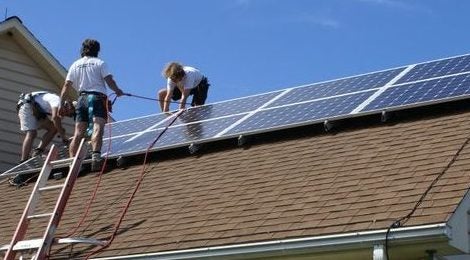Can blockchain empower individuals to take control of the electric grid?

Empowering individuals to be their own energy producers is fundamental to reforming our energy system so that it benefits everyone. In the current system, there are few producers of energy, such as large, centralized power plants, and many consumers (i.e., homes, businesses, factories).
A new technological solution, blockchain, seeks to make our system more “transactive”. Individuals, such as solar homeowners, would be empowered to sell, or transact, the electricity they generate. Currently, blockchain technology is most commonly associated with cryptocurrencies, like Bitcoin. But that’s only one possible use for it. Investors are spending hundreds of millions of dollars to see how blockchain can be used to facilitate the trading of electricity.
Blockchain works by facilitating electronic peer-to-peer transactions over a decentralized network. Two years ago, we wrote about one such network in New York City that is enabling neighbors to sell solar energy to each other.
“A blockchain well-designed for the energy sector becomes attractive on two fronts,” said Peter Bronski, head of Marketing and Communications for the Energy Web Foundation (EWF). These two fronts are “how it makes existing processes better, such as disintermediating renewable energy certificate [i.e., REC] buying and selling and… how it unlocks new opportunities, such as more fully realizing the promise of peer-to-peer energy trading and other forms of transactive energy.” The technology could also be used to monitor energy usage to facilitate demand response or build energy management.
EWF is one group looking at potential blockchain applications for energy. Founded by the Rocky Mountain Institute and blockchain developer Grid Singularity, EWF is building its own core blockchain platform, one that is public and open-source, and specifically tailored to the energy sector.
A test version of EWF’s blockchain is live with its Tobalaba test network. EWF has more than 70 affiliate organizations on the website. These organizations include utilities, grid operators, and cleantech startups. “You’re seeing its real-time activity,” Bronski said, “including the network validator nodes that are confirming blocks of transactions and the speed at which new blocks are being added to the chain.”
There is also movement on the policy side as well. In July, the Arizona Corporation Commission opened a docket to understand how the technology could impact the energy sector.
Bronski has his own vision of that impact. For a homeowner of 2025 who has solar PV plus battery storage, and perhaps an electric vehicle, a smart thermostat, and a grid-interactive electric water heater as well, an energy blockchain might help in several ways. If you want to get paid by the utility for providing grid balancing services with your smart energy devices, or if you and your neighbors wish to create a self-sufficient district to trade clean energy among yourselves, blockchain applications are being developed for these uses. And in case you’re a homeowner who can’t, or doesn’t want to own a solar PV system, but still wants 100 percent green energy, a blockchain-based solution could automatically procure renewable energy certificates matched to your home’s electricity consumption.
Despite its promising first steps, blockchain for the energy sector still has a long way to go. The technology is very much in the “infant” stage. Additionally, there is not currently a regulatory framework to support the type of peer-to-peer trading that blockchain could enable. Finally, there needs to be far more producers of energy, such as solar homeowners, in order to make our grid system truly transactive.
